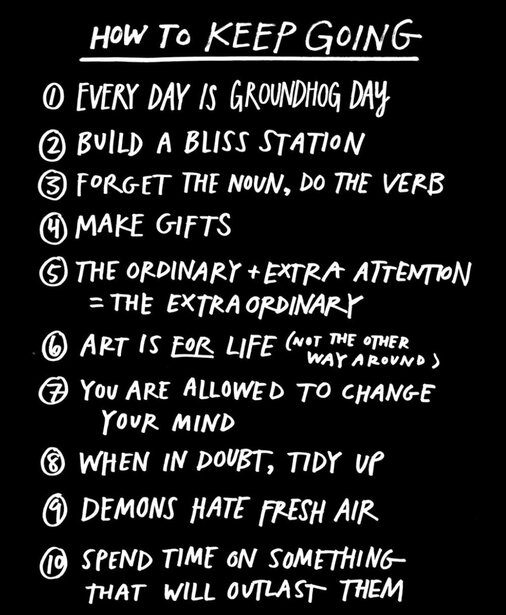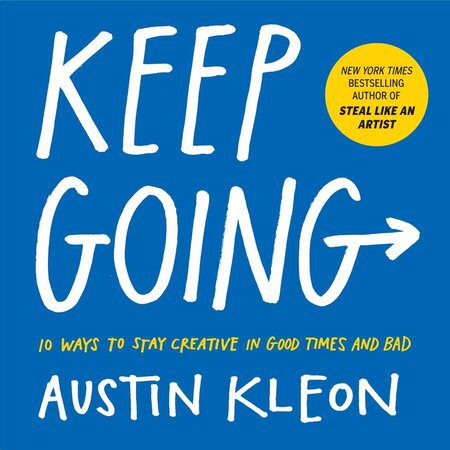In Keep Going: 10 Ways to Stay Creative in Good Times and Bad, author Austin Kleon shares 10 ways to stay creative, focused, and true to yourself during the good and bad times.

- Everyday is ground hog day
The creative life is not linear. It’s not a straight line from point A to point B. It’s more like a loop, or a spiral, in which you keep coming back to a new starting point after every project. No matter how successful you get, no matter what level of achievement you reach, you will never really “arrive.” Other than death, there is no finish line or retirement for the creative person.
“Relying on craft and routine is a lot less sexy than being an artistic genius. But it is an excellent strategy for not going insane.”—Christoph Niemann
On Routine
When you don’t have much time, a routine helps you make the little time you have count. When you have all the time in the world, a routine helps you make sure you don’t waste it. What your daily routine consists of is not that important. What’s important is that the routine exists. Cobble together your own routine, stick to it most days, break from it once in a while for fun, and modify it as necessary.
2. Build a Bliss Station
Creativity is about connection—you must be connected to others in order to be inspired and share your own work—but it is also about disconnection. You must retreat from the world long enough to think, practice your art, and bring forth something worth sharing with others. You must play a little hide-and-seek in order to produce something worth being found.
In The Power of Myth, Joseph Campbell said everyone should build a “bliss station”:
You must have a room, or a certain hour or so a day, where you don’t know what was in the newspapers that morning, you don’t know who your friends are, you don’t know what you owe anybody, you don’t know what anybody owes to you. This is a place where you can simply experience and bring forth what you are and what you might be. This is the place of creative incubation. At first you may find that nothing happens there. But if you have a sacred place and use it, something eventually will happen.
The greatest need of our time is to clean out the enormous mass of mental and emotional rubbish that clutters our minds and makes of all political and social life a mass illness. Without this housecleaning, we cannot begin to see. Unless we see, we cannot think. —Thomas Merton
3., Forget the Noun, Do the Verb
Lots of people want to be the noun without doing the verb. They want the job title without the work. Let go of the thing that you’re trying to be (the noun), and focus on the actual work you need to be doing (the verb). Doing the verb will take you someplace further and far more interesting.
Creativity is just a tool. Creativity can be used to organize your living room, paint a masterpiece, or design a weapon of mass destruction. If you only aspire to be a “creative,” you might simply spend your time signaling that you are one: wearing designer eyeglasses, typing on your Macbook Pro, and Instagramming photos of yourself in your sun-drenched studio.
I don’t know what I am. I know that I am not a category. I am not a thing—a noun. I seem to be a verb, an evolutionary process. —R. Buckminster Fuller
4. Make gifts
One of the easiest ways to hate something you love is to turn it into your job: taking the thing that keeps you alive spiritually and turning it into the thing that keeps you alive literally. You must be mindful of what potential impact monetizing your passions could have on your life. You might find that you’re better off with a day job.
When you start making a living from your work, resist the urge to monetize every single bit of your creative practice. Be sure there’s at least a tiny part of you that’s off-limits to the marketplace. Some little piece that you keep for yourself.
It’s always good to have a hobby where there’s no way to monetize it . . . So follow your dreams, but right up to the point where they become your job, and then run in the other direction.—David Rees
Suckcess
“Suckcess,” is success on somebody else’s terms. Or undeserved success. Or when something you think sucks becomes successful. Or when success or chasing after it just plain starts to suck.
Where there is no gift, there is no art.
When our art is taken over by market considerations—what’s getting clicks, what’s selling—it can quickly lose the gift element that makes it art. We all go through cycles of disenchantment and re-enchantment with our work. When you feel as though you’ve lost or you’re losing your gift, the quickest way to recover is to step outside the marketplace and make gifts.
5. The Ordinary + Extra Attention – The Extraordinary
For anyone trying to discern what to do with their life: PAY ATTENTION TO WHAT YOU PAY ATTENTION TO. That’s pretty much all the info you need.—Amy Krouse Rosenthal
What you choose to pay attention to is the stuff your life and work will be made of. We pay attention to the things we really care about, but sometimes what we really care about is hidden from us.
6. Slay the art monsters
Art is supposed to make our lives better.
This is as true for the making of the art as it is for the art itself. If making your art is ruining anyone’s life, including your own, it is not worth making.
7. You are allowed to change your mind
To change your mind is to do some real thinking. Thinking requires an environment in which you can try out all sorts of ideas and not be judged for them. To change your mind, you need a good place to have some bad ideas.
No, if you’re going to change your mind, you might have to go off-brand, and offline is the place to be off-brand. Your bliss station, your studio, a paper journal, a private chat room, a living room full of trusted loved ones: These are the places to really think.
8. When in doubt, tidy up.
Creativity is about connections, and connections are not made by siloing everything off into its own space. New ideas are formed by interesting juxtapositions, and interesting juxtapositions happen when things are out of place.
Art is not only made from things that “spark joy.” Art is also made out of what is ugly or repulsive to us. Part of the artist’s job is to help tidy up the place, to make order out of chaos, to turn trash into treasure, to show us beauty where we can’t see it.
9. Demons hate fresh air
When we’re glued to our screens, the world looks unreal. Terrible. Not worth saving or even spending time with. Everyone on earth seems like a troll or a maniac or worse. But you get outside and you start walking and you come to your senses. Yeah, there are a few maniacs and some ugliness, but there are also people smiling, birds chirping, clouds flying overhead . . . all that stuff. There’s possibility. Walking is a way to find possibility in your life when there doesn’t seem to be any left.
Go out and walk. That is the glory of life.—Maira Kalman
10. Plant your garden
You have to pay attention to the rhythms and cycles of your creative output and learn to be patient in the off-seasons. You have to give yourself time to change and observe your own patterns.
Draw the same tree every week for a year. Take up casual astronomy. Watch the sun rise and set for a week. Observe the moon every night for a few cycles. Try to get a feel for non-mechanical time, and see if it recalibrates you and changes how you feel about your progress.
Our lives, too, have different seasons. Some of us blossom at a young age; others don’t blossom until old age. Our culture mostly celebrates early successes, the people who bloom fast. But those people often wither as quickly as they bloom.
All the Best in your quest to get Better. Don’t Settle: Live with Passion.



Comments are closed.